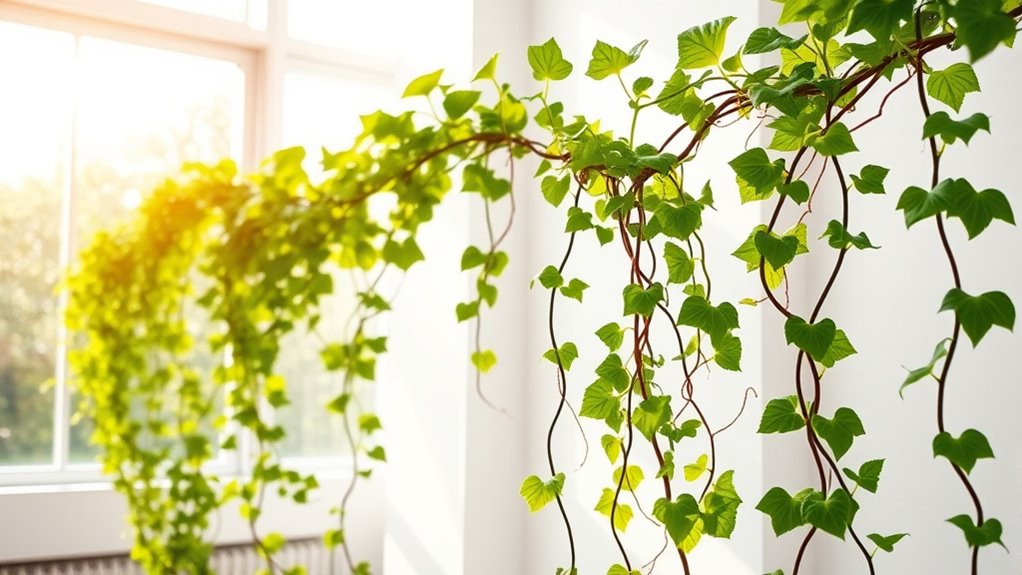Summer is the perfect time to prune and train your indoor vines for controlled, lush growth. Focus on removing dead or overcrowded stems and guiding shoots along supports like trellises or stakes. Regularly check for pests and adjust ties as your vine grows. Proper watering is essential to keep plants healthy and stress-free. Stay attentive during this season, and you’ll soon discover effective techniques to shape and maintain beautiful, well-managed vines.
Key Takeaways
- Prune indoor vines during summer to remove dead or overcrowded stems, promoting healthy growth and airflow.
- Use supports like trellises or stakes and secure vines with gentle ties to guide their shape.
- Regularly trim just above leaf nodes to encourage dense foliage and prevent unruliness.
- Inspect for pests during pruning and remove affected parts to maintain a pest-free environment.
- Ensure consistent watering and keep tools clean to support vigorous, controlled vine growth.

As summer arrives, it’s the perfect time to prune and train your indoor vines to promote healthy growth and maintain the desired shape. During this season, your plants are actively growing, making it easier to shape them and encourage new, vigorous growth. Before you start, review your watering schedule. Consistent watering is vital—water your vines when the top inch of soil feels dry, ensuring they stay hydrated without becoming waterlogged. Proper watering supports healthy growth and helps prevent common pests that thrive in overly moist environments. Regularly inspect your plants for signs of pests like spider mites or aphids, which can weaken vines and hinder their development. Managing pests early keeps your vines healthy and guarantees your pruning efforts are effective.
Summer is ideal for pruning, training, and maintaining healthy, pest-free indoor vines.
When it comes to pruning, focus on removing dead, damaged, or overcrowded stems. Trim just above a leaf node to encourage new shoots and maintain the desired shape. Don’t be tempted to over-prune; instead, aim for a balanced look that promotes airflow and light penetration. Training your vines involves guiding their growth along trellises, stakes, or other supports. Use soft ties or plant clips to secure shoots gently, directing them where you want them to grow. As your vines extend, continue pinching back new growth to prevent them from becoming unruly. This not only helps maintain the aesthetic but also fosters denser foliage and stronger stems.
Training is an ongoing process that benefits from consistent attention. As your vines grow, you might need to adjust ties or reposition stems to keep them aligned. Be mindful of the growing tips and encourage horizontal or upward growth depending on your space and aesthetic goals. Remember, good airflow is essential—prune to prevent overcrowding, which can lead to fungal issues or pest infestations. Regularly check for pests while pruning. Removing affected leaves or stems reduces hiding spots and minimizes pest populations.
Keep your indoor environment clean and free of debris, as fallen leaves can attract pests. Maintain your watering schedule diligently because overwatering or underwatering can stress your vines, making them more susceptible to pests and diseases. Proper watering and pest management are keys to healthy, controlled growth. Additionally, using an airless paint sprayer for cleaning tools or surfaces can help maintain a sterile environment and prevent the spread of pests or diseases. By staying attentive during summer, you give your indoor vines the best chance to thrive. With consistent pruning, training, and vigilant care, your vines will grow lush, well-shaped, and free from pests, transforming your indoor space into a thriving green oasis.
Frequently Asked Questions
How Often Should Summer Pruning Be Performed for Indoor Vines?
You should consider the timing considerations and pruning frequency for indoor vines to keep them healthy. Typically, summer pruning is done every 4 to 6 weeks during the growing season, but this can vary based on the vine’s growth rate. Regular pruning encourages new growth and maintains your plant’s shape. Keep an eye on your vines, and prune as needed to promote controlled growth and prevent overgrowth.
Can Summer Pruning Damage the Vine’S Overall Health?
Worried about warranting vine damage? Summer pruning, if done at the right timing, can actually help reduce vine stress by encouraging healthy growth. However, poor pruning timing or over-pruning can damage the vine’s delicate defenses, leading to stress and potential disease. You should prune selectively, not sparingly, and always consider the vine’s health and growth cycle to prevent harm and promote vibrant, vigorous vines.
What Tools Are Best for Pruning Indoor Vines?
When pruning indoor vines, you want tools that are precise and clean. Pruning shears are ideal for thicker stems because they cut smoothly without crushing the plant. For smaller or delicate branches, plant scissors work best, offering control and accuracy. Using sharp, sterilized tools helps prevent disease and guarantees healthy growth. Always choose quality pruning shears and plant scissors to make clean cuts and keep your indoor vines thriving.
How Do I Train Vines to Grow Vertically Indoors?
Think of your indoor vines as dancers enthusiastic to reach the spotlight. To train them vertically, you’ll want to use effective training techniques like gentle guiding and tying. Support structures such as trellises, stakes, or wires act as the stage, giving your vines a framework to climb confidently. Regularly adjust the vines, encouraging upward growth while preventing tangles, and watch as your indoor garden reaches new heights with elegance.
Are There Specific Vine Varieties That Respond Better to Summer Pruning?
You’re wondering if certain vine varieties respond better to summer pruning. Generally, variety compatibility and growth habit matter—some vines like mandevilla and philodendron are more receptive due to their flexible growth habits. These plants tend to recover quickly and respond well to pruning, encouraging healthy, controlled growth. Before pruning, check your vine’s specific needs, as understanding its compatibility and growth habit helps guarantee successful summer pruning and ideal indoor growth.
Conclusion
By mastering summer pruning and training, you hold the brush to your indoor vines’ masterpiece. Think of your plants as dancers, each move shaping their graceful growth and vibrant beauty. With careful guidance, you’ll turn a simple vine into a lush, controlled display of nature’s artistry. So, take the reins and nurture your indoor garden—because, in the end, a well-tended vine is a proof to your patience and passion.











